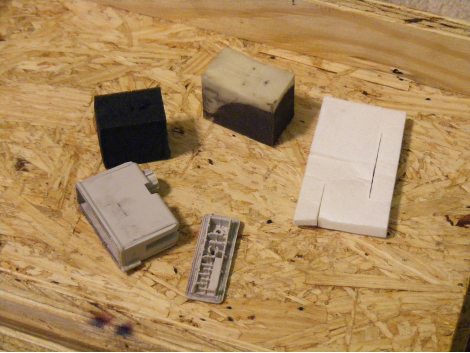
The number one and number two things asked after presentation of our DIYDTG were…
“How does it hold up in the wash?”
and…
“How did you change out the inks?”
While we’ve explained the first several times (regular ink washes out, DTG ink gets a little lighter but survives) we can hopefully answer the second with a tutorial.
To change out or refill the Epson cartridges we used was relatively simple. You’ll need a few supplies.
-Old/used (or new, but you would be wasting ink) Epson cartridge
-DTG ink (we recommend DTGinks.com)
–SSC utility (this lets your trick the printer into thinking it has a fresh cartridge)
-Windex (ammonia base won’t rust the print head)
-Plastic syringe
-Flat head screw driver
-Hot glue
-Electrical tape
-Small cup
-Rags (ink gets everywhere)
-Resolve or other stain remover (to clean up said ink everywhere)
-Time (a lot of it)
-(Optional) sponge from other printers
-(Optional) latex gloves
-Original head waste collection piece from printer.
The bottom item on the list is a small funnel and squeegee that were originally located just below the head when it is at ‘home’ position within your printer. Its job was to suck ink out of the head, cleaning it and priming it at the same time.
Fair warning, your fingers will be black/stained without gloves.
You’ll want to first take the flat head screwdriver and crack open the cartridge’s top. Make sure it stays intact, we will be reusing it and glueing it back on. From there, pull out the old sponge that resides in the cartridge.

Pour some Windex in a cup and place in the cartridge and top. You can either soak the original sponge as well in the cup, or cut a new sponge. We don’t recommend kitchen sponges (too many large holes), but we found several clean sponges in old printer’s ‘ink recycle receptacle’ – for lack of a better term.
Let it soak (we recommend overnight).
I’ll take this moment to explain how to prime your head. You’ll want to make sure you put in some cartridge: ink, DTG ink, Windex, or other. Just don’t try to prime your head with air/no cartridge!
Take your syringe, and push it onto the hose that is connected to the waste collection piece.
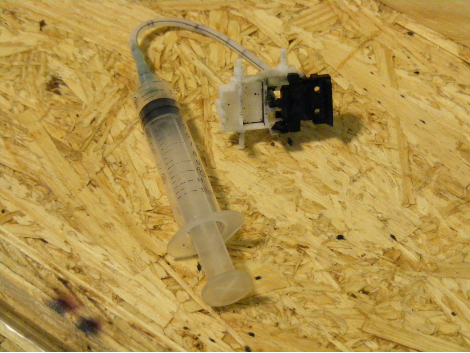
You’ll position it below the head’s nozzles (seen in the picture below as dots), push it against the head with one hand. Using your other hand, pull out the syringe (creating a vacuum). You should get a nice thick stream of whatever cartridge you put in. If not, wiggle around the waste collection piece until a seal is formed. We pull out on average about 1ml of liquid to prime.

(Optional) If you think your printer has a lot of clogged heads, you can take out the cartridge from the cup. Place it in your printer head, and fill it with Windex. Prime as explained above. Your heads should be clean and clear.
Once your sponge has soaked (or you cut a new one), simply drop ink/DTG ink onto the end of the sponge that will be pushed into the cartridge first. We used about 10ml, do NOT fill your sponge completely.
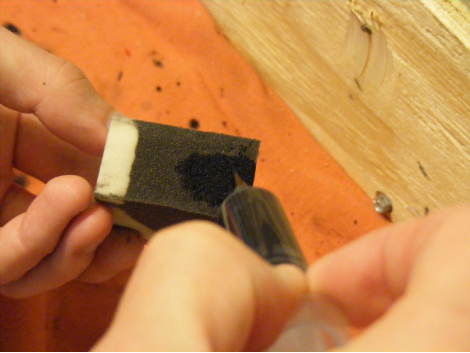
Stuff the soaked end first into the cartridge, pushing it down to the bottom, but make sure you don’t push too far, the top of the sponge has to touch the lid (why that’s important in a moment).
You’ll notice that by squashing down the sponge into the cartridge, the extra previously unfilled area of the sponge gets soaked.

Push on your lid, and hot glue around the edge, it must be air tight (but not so much so you can’t ever get the lid off again, we assume you’ll want to refill again). And place a small amount in any holes except the main center one.
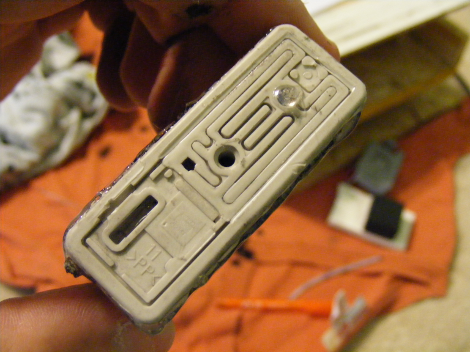
By having the lid done this way (with the sponge and glue) you’re creating an air tight seal that only lets out the correct amount of ink. If you cleaned out your head before with Windex (that optional stage), with no sponge and no lid as instructed, you may have noticed just how easily without this seal that fluid will just fall out of the head, you don’t want that.
(Pictured below, ink dribbling out)
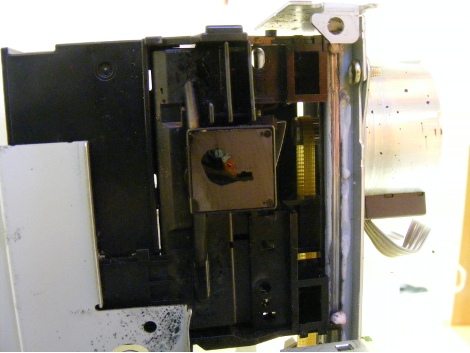
Wrap a tight piece of electrical tape over the cartridge, covering and sealing the bottom hole completely. Only once around is needed, too many and the plastic spike may not be able to pierce the tape.
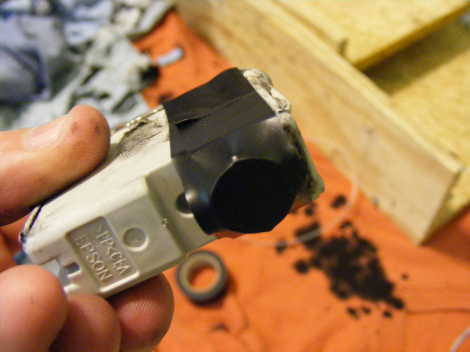
Place the cartridge into the head, from here on out, until the cartridge is completely empty, do NOT remove it from the head. Prime your head. At this point if you put too much ink into the sponge you’ll see it fall out of the head (as mentioned above). Don’t worry, just leave it. Place a rag underneath and wait (once again, overnight is prefered). By morning you should be able to wipe away all the excess, prime it, and no ink will ‘just fall out’.
We also added a small piece of rag to act as a squeegee to help clean the head when it returned to home position.
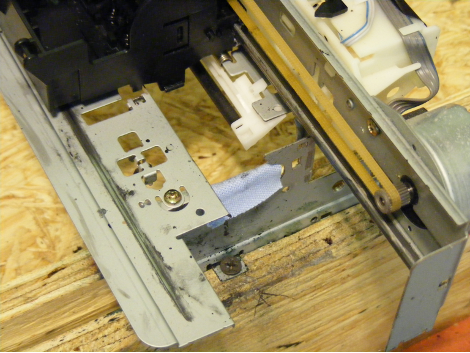
You’re done! Do a lot of test printing, you’ll find that some of the first prints will be messy (it took us 10 full prints before we got it to be constant darkness).















I’m guessing something like a CISS would also work well if you replace the inks?
I was also thinking a CISS would be a lot easier to deal with
people continue to print with ink?
That’s a pretty arrogant remark.
Wise people who are far superior and intelligent to the likes of you, know that you always use the best tool for a given job.
If that means you use ink, you use ink.
If that means you use a pipe wrench on that big ole nasty nut you don’t have a regular wrench for, you use a pipe wrench.
HackADay is a site about hacking stuff for no other reason than the joy of the accomplishment.
If you don’t have the brains to figure that out, you should not be reading, let alone be posting remarks on HackADay.com.
Now go away egotist, you’re disrupting the creative genius’ here.
I think that toner transfer probably wouldn’t be the easiest method to print onto cloth with :D
You can use toner but it requires a special method and also does not stick.
You have to have specialized toner that specialized lasers use in order for
that to work.
I should have said is not permanent.
YOU GUYS FRIGGIN ROCK! Keep up the awesome work!
Oh is that all you have to do?
Someone can make a lot of money if they start selling replacement DTG carts.
After a few years of experimenting with silkscreening by designing and building my own four colour press and playing with many inks to find what worked well, this shall be an interesting endeavour into the next realm.
Thanks!
There are many epson cartridges what you can fill on the top easily.
The issue is the counter chip on it.
All the entry/midclass printer cartridges work on the same way. When you start the printer its reading the counter data from the chip to see if theres enough ink, when you shut the printer down its gonna write the data out.
Only the high end ones have real sensors inside which indicates the ink ran out.
With the old printers you could have play the game to put in a full cart turn it on, replace it with an empty cart, turn it off to write the data back to it but of course its not the best business for fucking epson so you cant do this with many new printers. I saw some which has a mini reset button on it but its not common either.
Instead of writing some obvious guide reverse the chip and find a way to make a writer for it which easily attachable for pcs…
@M4CGYV3R take a look at DTGinks.com
Now, how do we print white ink?
How to print white ink as base?
Too much info.. have to do more reading..
By the way this is how they do it on regular DTG
http://www.youtube.com/watch?v=b0VQezt_EGI
I hate printer ink.
I hate Pete.
I hate NOT to know why the soaking and why the electric tape.
I believe the soaking is to clean all the old ink out before you put in the DTG ink. The tape is to make a seal so the ink doesn’t leak before it gets placed into the printer.
I have an older Canon printer, ip1800, I opened up the cartridges by sawing between the cap and body of the cartridge, the cap popped off easily and I pulled out the sponges and refilled. I will try your version if I have to buy a new printer. Thanks.
I wonder – how did you bypass the paper roller
Sensor from your Canon printer? So printer will
print it out with out searching for plain paper?